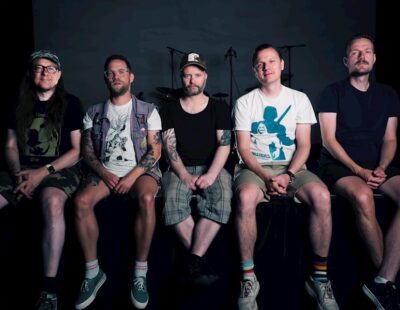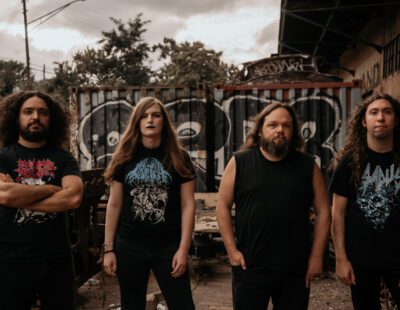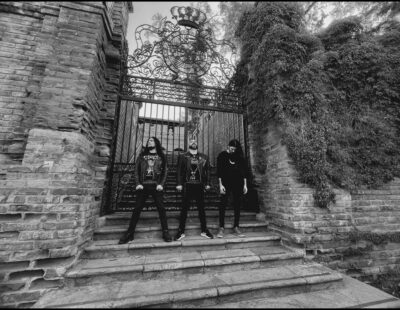Semi-rural, semi-suburban Maryland is hardly an obvious spawning ground for gritty black metal. With Washington D.C. and Baltimore hogging all the attention, and Frederick area bars almost exclusively hosting good-time cover bands of dubious quality, the area’s heavy music scene is pretty damn subdued.
Dweller in the Valley drummer/vocalist Dane Olds is a current Frederick, MD resident, transplanted from the Midwest, who bucks the trend. Not only was he able to gather a few coworkers to play in a band, that band turns out to have some incredible drive and both the songwriting acumen and technical ability to pull off some extremely strong material.
We sat down with Dane over plates of buffalo chicken strips and eggplant fries to discuss the band and their new recording, Younger Dryas. The two-hour conversation rolled through such topics as recording techniques, the death versus black aesthetics, human past and destiny, and the unsettling philosophical leanings of black metal’s progenitors. Some of that conversation has been transcribed here to help you get to know the band, but far more important is the music (obviously). You can check out the first song on the new recording, “The Shedding,” right here on the Deciblog, and if it’s right for you, go find more at the Bandcamp sites set up by the band and the label.
Younger Dryas is being released today through Grimoire Records, and Dweller in the Valley is celebrating tomorrow night, May 31st with a show at Guido’s on 6th Street in Frederick, alongside Grimoire labelmates Torrid Husk and others. As the summer progresses, Dweller in the Valley will also play shows with Hexer, Lychgate and Mutilation Rites, so you central Maryland metalheads have no excuse not to see them kill it live. For now, here’s seven minutes of their thoughtful, savage metal.
What were you doing before Dweller in the Valley started?
[Grinning March of Death] was pretty much a mid-aughts death metal project – you know, very oriented towards Cannibal Corpse, I was listening to a ton of Nocturnal by Black Dahlia Murder, we threw a little Skeletonwitch influence in there. Nate, our bass player, and I pretty much bankrolled the band, and we actually did it for five years. The problem with that project was we could only practice maybe once a week because the space we were using was Nate’s place, and he had several roommates. He didn’t want to subject them to that more than once a week. And we were all busy with work. It took us a while, but we ended up having an album’s worth of material. We only did one show before our guitar player decided he didn’t want to do it anymore. That ended up leading to Dweller in the Valley.
And how long has Dweller existed?
I think it was late 2011 when Grinning March of Death had our last show, so it was probably into 2012. We’ve been doing it about two years. It’s all guys at the [game design] studio that are doing the project. A good buddy of mine introduced me to [guitarist Mike Merriam], and I just had Mike come over to jam one time and it was like [snaps] immediate, like yeah, this is gonna work. In that time, I had really gotten into a lot more black metal…
For the sound or the playing style?
Kind of all of it. You can only listen to tech death so long before you [feel like], “Man, I’m listening to a robot.” Honestly, Fear Factory hit most of those notes with Obselete years ago. You can sort of extrapolate from there, and that’s where we get a lot of the tech death stuff, and after a while it all felt a little too polished, a little too clean. It just wasn’t grabbing me anymore, and I had a friend at the [game design] studio that turned me on to it. I had been aware of black metal…
You can’t not be aware of it…
Yeah. In high school I was in a shitty nu-metal band, like everybody was in high school, and there was an awesome underground metal shop up in Indianapolis, right next to the Emerson Theater – we had some shows up there – and I remember going in at the time. My tastes had not developed at all at that point; I simultaneously liked really awful nu-metal and Cannibal Corpse and was a huge At the Gates fan even back then. So we went to this little independent metal shop and they had this Slaughter of the Soul longsleeve t-shirt and a copy of Terminal Spirit Disease, and I remember pawing through Immortal CDs. My funds were very limited and tracking that stuff down on the Internet was very different than it is today. I was really into the Scandinavian death metal stuff. I was aware of black metal, but it wasn’t anything that had really grabbed me quite yet.
I actually had heard it back then and didn’t like it. I was really more into everything being super precise… I think a lot of metal people start out that way – it can be super heavy and super fast, but everything needs to be right on time. [Later,] a lot of what was happening in death metal started to get kind of tired. That’s not to say there aren’t tons of band who are really sick, awesome death metal…
I see your Horrendous shirt…
Yeah, Horrendous is amazing! They’re one of my favorite bands, just uncompromising death metal that’s looking to an older sound, atmosphere more than blast beats, and it’s all about vibe. Actually, they were pretty influential on me when I was writing the initial Dweller stuff. That was really where I started to go with my thinking about music: Don’t worry about showing off, don’t worry about your chops, worry about creating a feeling. The chops should serve that, not the other way around.
That was really when I began to crystallize what I wanted to do with Dweller, listening to bands like Portal and… not that we sound like it at all, but I was spinning a lot of the Cascadian stuff. I went out to the first Gilead Music Fest in Wisconsin, and [those artists] clicked with me in a way that metal hadn’t for a really long time – bands like Hell and Thou and Ash Borer. At that festival I was kind of exposed to it all at once. “Woah, this is new, this is something I really click with.”
So those Gilead Fest artists impacted you in a live setting. Do you feel any differently about those bands’ recordings?
When I first started listening to Ash Borer, I got their first demo on vinyl, and when I spun it I was like, “Oh my god, this is huge!” But then seeing those guys and Fell Voices… I was familiar with their work, I had spun it at home and I was into it, but seeing it live is just something else entirely.
With the Grinning March of Death, we spun our tires for five years, we didn’t record anything because I didn’t really know what I was doing. Initially with Dweller, I was actually going to go really old-school [with] an old Tascam PortaOne 4-track cassette recorder, until the belt broke. As much as I wanted to be true to that format, I thought I could figure out how to hook up an interface and record it digitally. So that’s what I did, at home. You know, the early [black metal artists] just wanted to get the thing recorded, and the lo-fi sound was a huge part of it, a total middle finger to metal as it was being recorded up to that point. That definitely resonated with me.
So we were not recording to a click, nothing like that. Weirdly enough, with our demo cassette, Breath of the Void which just came out on Black Mess Records out of Baltimore, I decided to play the drums [first]. I wanted it to sound like what I’m doing – if I’m tired, I slow down; if I have a particular spot that I’m struggling with, it’s going to sound like I’m struggling with it. That was very different from my previous mindset, [where] it had to be perfect, it had to be spot-on. I felt that, in a way, that spirit of lo-fi black metal recording liberated my mindset about recording metal. I’m really happy with how the stuff has gone.
How long did it take to put Younger Dryas together?
We did it in a day. I had bought these singing bowls when I took a trip to the United Arab Emirates last year. It was my first time out of the United States, definitely an eye-opening experience for this Midwestern boy. I’ve always liked [the sound of] chanting and throat-singing and traditional instruments that aren’t used traditionally in black metal, and I had this idea for this intro. “The Shedding” has this long, drawn-out bass feedback intro and I wondered what it would sound like to incorporate some of those sounds into it. I’m actually doing the throat-singing and playing the singing bowls. It turned out so much better than I could have hoped.
What do you think of the local metal scene here?
One of the things that’s so amazing now is seeing how many amazing acts are springing up in the area: Dendritic Arbor, Horde of the Eclipse, Wrought Iron, Torrid Husk, Dispellment, Permafrost… there’s really good stuff right in this region. One of the things I think is awesome about Grimoire – as a label, they’re documenting it.
What kinds of personalities feed into Dweller in the Valley?
I tend to be more driven [toward the] philosophy behind it, thinking about the nuance of it. We all have very different personalities. Nate, our bass player, is super laid back, a really chill guy. He’s also really good at organizing – I’m an artist by trade, so when I’m busy doing the lyrics and artwork, I know I can go to him for some help to get shit in a row, and he really helps me do that. He puts all of our concerts on a calendar. Mike, our guitar player, is also super laid back. He’s a huge gamer. He’s really goofy, he likes to joke a lot… actually, he and Nate both like to joke a lot. I tend to be the more serious one. They keep my head on my shoulders. They let me steer the ship as much as I want, which is really awesome. They let me push it in the direction that I’m feeling passionate about, and then when I can’t [bear being in charge anymore] then they’re like, “Alright, we’ve got it for a little bit.” We work really well as a unit.






